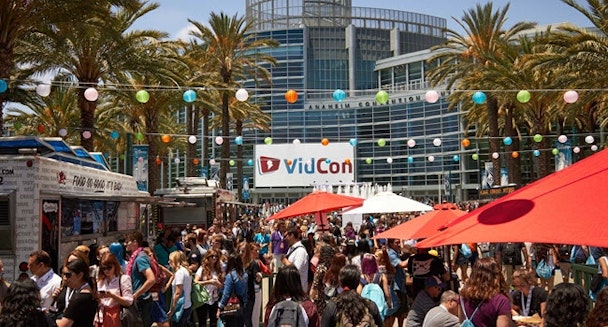VidCon is more important than Cannes : Here’s what you missed
Cannes…the Coachella of the ad industry. But, while you were poppin’ bottles and praising bespectacled creative directors, I was with 60,000 screaming teenagers and the YouTube/ Instagram stars they worship in California at VidCon.

vidcon
If your brand or agency wants to be around in 10 years time, you need to stay culturally relevant. Where better to soak up culture than amongst the people who are defining what online video should look like and understanding them better.
But then Cannes has always been backwards looking, and VidCon is much more about the future. Here are some actionable insights from this pop culture explosion that will be more useful for you than any glorified p*ssup in adland.

1. Creators, not influencers
They call themselves ‘creators’ because they’re creative. And guess what - they’re quicker than brands & agencies are at producing high quality content for multiple channels. They know their audiences more intimately than any audience trend analysis report. We need to get slicker with ways of working and understand how they create in order to keep up. We should be treating Creators like production partners – ask for treatments, storyboards, scripts and collaborate with them. Invite them to PPM’s. They’re a lot more than just a man with a GoPro, now.
2. Followers don’t equal influence
Kim Kardashian’s brand promotions convert worse than a banner ad. A general rule is the larger the audience, the lower the engagement. Your brand and the creator you’re looking to work with should share a purpose, a vision, a specialism and their audience should be engaging with them more than passively scrolling past their content. You might be better off working with three creators at 100k followers each than with one creator with 3m followers
There are influencer qualification platforms popping up everywhere, but until platforms release APIs that give brands access to their analytics, we will struggle not to use some man-hours and good ol’ fashioned real life relationship building to help qualify creators and measure their campaign work.
3. Creators are everything to Gen-Z & they aspire to be creators themselves
I’ve started calling Gen Z ‘screenagers’, because to be without a phone if you’re 14 is not to exist. So much so that ‘YouTuber’ is now the No.1 career aspiration amongst Gen Z. And if that isn’t enough, 77% of Gen Z responders said they trust their favourite creators and see them as the trendsetters more than brands. If you’re offering includes Influencer marketing, you should be looking for “the next big” creators now. Also, what about creator internships/ trainings to start setting themselves apart in their category as thought leaders and building relationships for the future?
* insights from FirstChoice
4. Sorry, no one has standardized or nailed influencer fees yet
Even micro-creators are savvy about brand partnerships. Sure, pay with product is still a thing. But they’re inundated with free product offers in exchange for promotion. And no one has defined a formula yet, ie 100,000 followers is worth £XXX.
Here are the range of different ways creators are paid - Pay per post, Pay per view/ reach, Pay per engagement, Pay per year/ time period, Pay per sale, Pay with equity and Pay per NPD.
Whilst payment types are getting more and more varied and creative, measurement & ROI doesn’t seem to have been nailed yet. Brands like Samsung have a dedicated in-house team looking after creator relationships; they’re looking for long-term relationships that deliver more than tactical impact.
5. Prepare now for an ad-free future.
We’re already paying Netflix and Spotify to let us use their platforms ad free. 615m devices now use adblocking technology. That’s 11% of the global internet population actively avoiding ads.
Ad-free YouTube Red is rolling out wider (announced at VidCon), adding more premium content - you've got to start wondering, what happens when digital platforms all go pay-to-play-ad-free?
Here are 3 things I think will happen:
- Influencer Marketing will take precedence. Now is the time to test & learn, create work streams to make it easier and simpler for agencies, influencers and brand teams alike to work in this way.
- Product placement will be back on the map, but we'll need to do it in more interesting ways. Characters in original series will need to do more than have your brand in hand. They need to share your brand values and become the living, breathing ambassadors for your brand on-screen
- Advertising will stop being so much like advertising. How can advertising evolve into something engaging and useful and additive to the internet instead of being this interruptive annoyance in exchange for digital services? Humanising your brand by staying culturally relevant is one way.
Also, imagine if brands actually commit to this thought of being additive to the world instead of interruptive. Why didn't a travel brand create Instagram, for example? Brands and agencies need to start thinking differently if we're to still have jobs in 10 years time.
Michaela MacIntyre is business director at Gravity Thinking.
Content by The Drum Network member:

Gravity Thinking
SOCIALLY CONNECTED COMMUNICATIONS
At Gravity Thinking we create work that maximises the opportunity social media offers brands. From content that competes...

